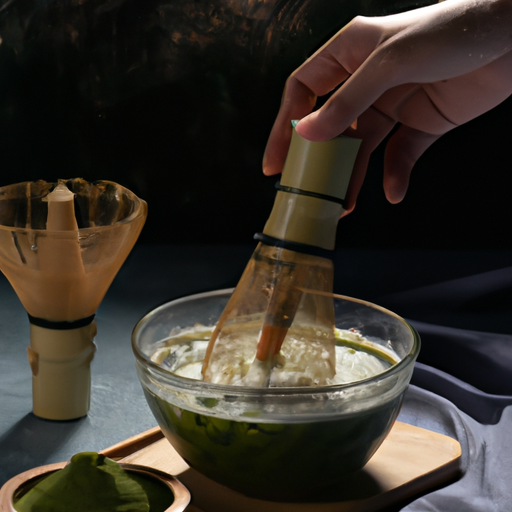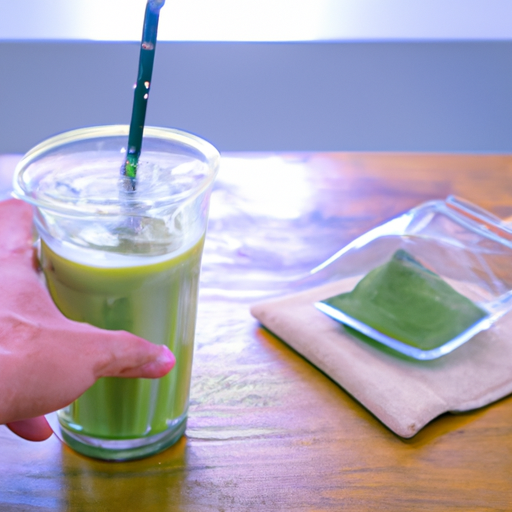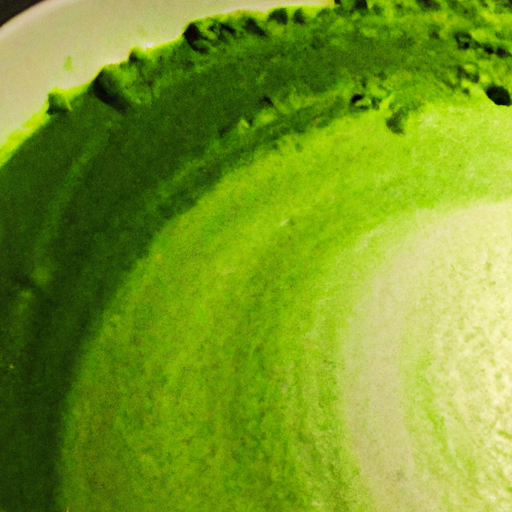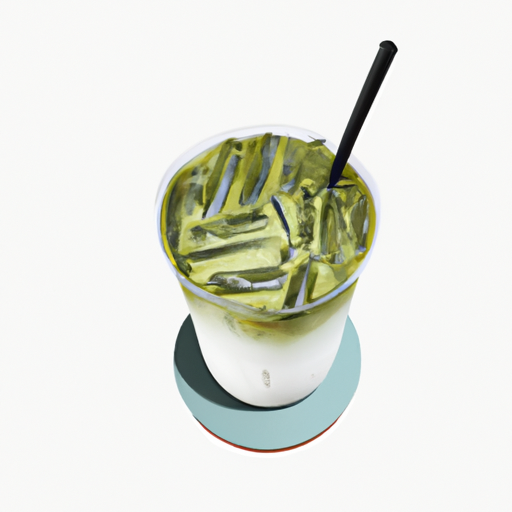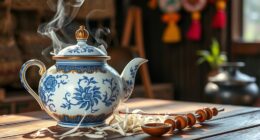Hello, fellow enthusiasts of boba! Are you into matcha and searching for a fresh method to experience it? Search no more, matcha boba is here for you.
This delicious drink combines the earthy flavors of matcha with the chewy texture of boba balls, making for a unique and satisfying experience.
To make this drink at home, all you need are a few simple ingredients and tools. Don’t worry if you’ve never made boba or brewed tea before – I’ll guide you through each step.
With just a little bit of effort, you can create your own refreshing and energizing matcha boba that’s sure to impress your taste buds. So let’s get started!
Key Takeaways
- Making boba balls involves mixing tapioca flour with boiling water, rolling into small balls, and cooking in boiling water for 20 minutes, with various flavors able to be added for extra taste.
- Matcha tea is made with high quality ceremonial grade matcha powder, whisked properly with a bamboo whisk, and sweetened with honey or sugar to balance out bitterness. Different grades of matcha powder are available, each with a unique flavor profile and quality.
- Combining boba balls and matcha tea involves stirring them together in a cup, with milk or cream able to be added for a creamy texture and non-dairy options available. Toppings like whipped cream or sliced fruit can also be added for extra enjoyment, and customization and personalization of the drink is encouraged.
- Matcha boba can provide numerous nutritional benefits, including high levels of antioxidants and nutrients that help protect cells from damage caused by free radicals and fight off harmful toxins. Customizing matcha boba with different flavor combinations allows for reaping the many health advantages that come with drinking it.
Gather Your Ingredients and Tools
Now you’re going to need a few things if you want to make some delicious matcha boba, so let’s get started!
First and foremost, we’ll need the ingredients. For this recipe, you’ll need tapioca starch or flour, matcha powder, sugar or sweetener of your choice, and milk or non-dairy alternative. You can also add different flavors like vanilla extract or honey for added taste.
Next up are the tools. Different types of boba tools are available in the market that can help you make perfect boba balls. Some popular ones include a rolling pin, measuring spoons/cups, silicone mat/gloves for easy handling of hot dough, and a slotted spoon to scoop out cooked boba balls from boiling water. However, if you don’t have these specific tools on hand, don’t worry—you can use everyday kitchen items such as a flat-bottomed glass for flattening the dough and a regular spoon instead of a slotted one.
With our ingredients and tools ready at hand, now let’s move on to making the boba balls.
Make the Boba Balls
Initially, mixing tapioca flour and boiling water together creates a dough-like texture for the boba balls. This process requires precise measurements of both ingredients to achieve the perfect consistency.
Once the dough is formed, it’s important to roll it into small balls that are uniform in size. I find that using a cookie scoop or melon baller makes this task much easier.
Cooking technique plays a crucial role in achieving the desired chewy texture of the boba balls. After rolling the balls, they should be cooked in boiling water for about 20 minutes or until they float to the surface of the pot. It’s important not to overcrowd them in the pot to ensure even cooking.
Once cooked, drain and rinse the boba balls under cold water before adding them to your drink.
To add extra flavor to your matcha boba, consider experimenting with different boba flavors such as honey or brown sugar. Simply add these ingredients into your tapioca flour mixture before forming into balls. The sweetness will infuse into each individual ball and enhance the overall taste experience of your drink.
Now that we’ve made our delicious boba balls, let’s move on to preparing our matcha tea!
Prepare the Matcha Tea
Now that the boba balls are ready, it’s time to prepare the matcha tea.
To make a delicious cup of matcha, there are three key points to keep in mind. First, choose the right matcha powder – look for high quality ceremonial grade matcha for the best taste.
Second, whisk the matcha properly using a bamboo whisk to ensure a frothy and smooth texture.
Finally, sweeten the matcha tea with honey or sugar to balance out its natural bitterness.
Choose the Right Matcha Powder
To get the best tasting matcha boba, it’s important to choose the right matcha powder – did you know that there are over 30 different grades of matcha? Each grade has a unique flavor profile and level of quality, which can greatly impact the taste of your boba. It’s important to consider factors such as color, aroma, texture, and taste when selecting your matcha powder.
To help guide you in choosing the right matcha powder for your boba, here is a table outlining some popular grades and their characteristics:
| Grade | Color | Aroma | Texture | Taste |
|---|---|---|---|---|
| Ceremonial Grade | Bright green | Sweet floral notes | Fine and smooth | Umami with slight bitterness |
| Premium Grade | Vibrant green | Fresh grassy scent | Silky and creamy | Mildly sweet with subtle bitterness |
| Culinary Grade | Dull green or yellowish | Earthy aroma | Slightly grainy or sandy | Bitter with less sweetness than higher grades |
When selecting where to buy matcha powder online, it’s important to research reputable brands and read reviews from other customers. Don’t be afraid to invest in a higher quality grade if you want a richer flavor profile in your boba. Now that we’ve chosen our matcha powder, let’s move on to whisking it together!
Whisk the Matcha
First things first, let’s talk about how you can achieve the perfect frothy matcha for your boba by whisking it just right. There are different grades of matcha to choose from. For making boba, it’s best to use a higher grade matcha that has a brighter green color and smoother taste. This will result in a richer flavor and better consistency.
Now onto the whisking techniques. To start, make sure you have a bamboo whisk or chasen and a bowl that is wide enough for whisking. Place 1-2 teaspoons of matcha powder into the bowl and pour in hot water (around 175°F) until the powder is covered. Use the chasen to whisk vigorously in a W motion until the mixture becomes frothy and smooth. Be careful not to over-whisk as this can cause bitterness in the tea.
Once your matcha is perfectly frothed, it’s time to sweeten it up with some simple syrup or honey.
Without skipping a beat, let’s move on to sweetening your matcha tea for boba perfection!
Sweeten the Matcha Tea
Achieving the perfect balance of sweetness in your frothy matcha can elevate your boba experience to a whole new level, leaving you feeling satisfied and content. Sweetening matcha tea is an essential step in making matcha boba, as it helps to cut through the bitterness of the green tea powder.
While traditional sweeteners such as sugar or honey are commonly used, there are alternative sweeteners that can infuse unique flavors into your matcha boba. One option for an alternative sweetener is agave nectar, which has a mild flavor and dissolves easily in liquids. Another option is maple syrup, which adds a rich and earthy taste to the drink.
Whatever sweetener you choose, be sure to add it slowly and taste frequently until you reach your desired level of sweetness. With the right amount of sweetener added to your whisked matcha tea, you’re one step closer to creating a delicious cup of matcha boba!
Now that we have our perfectly balanced matcha tea ready with just enough sweetness infused into it, our next step is combining it with cooked boba pearls to create our ultimate drink.
Combine the Boba and Matcha Tea
Now that you’ve got your perfectly cooked boba pearls and smooth matcha tea, it’s time to bring them together for a delicious drink.
Start by adding the desired amount of boba pearls to the bottom of your cup. You can adjust the sweetness level by increasing or decreasing the amount of syrup used in cooking the pearls.
Next, pour in your prepared matcha tea over the boba pearls. Gently stir the two together for a balanced taste of both flavors. Experiment with different toppings like whipped cream or sliced fruit to make your drink even more enjoyable.
Once you’ve combined the boba and matcha tea, it’s time to add milk or cream for a creamy texture. This step is optional but highly recommended for those who prefer creamier drinks. Add milk or cream until you reach your desired consistency, stirring gently as you go along.
With this final addition, sit back and enjoy every sip of your homemade matcha boba!
Add Milk or Cream
To get that creamy texture, you gotta add some milk or cream – it’s totally optional but highly recommended for a richer taste!
There are a variety of milk options you can use to customize your boba. Whole milk and half-and-half tend to be the most popular choices, as they provide a rich and indulgent flavor. If you prefer non-dairy options, almond, coconut, or soy milk work just as well.
When adding the milk or cream to your matcha boba, it’s important to consider the ratio of tea to dairy. For a lighter drink, use less milk or cream; for a more decadent treat, add more. You can also adjust based on personal preference – some people like their drinks sweeter than others and may want to add sugar or sweetener at this stage.
Now that you’ve added your desired amount of milk or cream, give everything a good mix with your straw before taking that first sip. The creamy texture will complement the grassy notes of the matcha perfectly!
Next up is customizing your drink even further with toppings and flavors.
Customize Your Drink
Ready to take your boba game to the next level? It’s time to get creative and personalize your drink with a variety of toppings and flavors! Boba is all about customization, so don’t be afraid to experiment and find your perfect combination.
Here are some ideas to get you started:
-
Toppings: From classic tapioca pearls to fruity popping boba, there’s a world of options out there. Try adding chewy mochi balls or crunchy almond bits for extra texture. If you’re feeling adventurous, sprinkle in some edible glitter or add a dollop of whipped cream on top.
-
Flavors: Matcha boba already has a deliciously earthy taste, but why stop there? Add a splash of vanilla syrup for sweetness or mix in some fresh fruit puree for a tangy twist. You could even try incorporating unexpected flavors like lavender or rosewater.
Remember, the beauty of making matcha boba at home is that you can truly make it your own. Don’t be afraid to play around with different combinations until you find what works best for you.
Once you’ve customized your drink just the way you like it, it’s time to serve and enjoy!
Serve and Enjoy!
Get ready to savor the delicious taste of your personalized boba creation, and take a moment to indulge in the perfect blend of flavors and textures. Now that you’ve added all your favorite ingredients and mixed them together, it’s time to serve and enjoy!
But before you do that, let’s talk about presentation tips. To make your matcha boba look even more enticing, consider adding some toppings like whipped cream or chocolate shavings. You can also add a drizzle of caramel or honey for extra sweetness. Don’t forget about the color palette too – try serving your drink in a clear glass so that the bright green hue of the matcha can be appreciated.
Flavor variations are another way to elevate your matcha boba experience. Experiment with different types of milk like almond or coconut milk instead of traditional cow’s milk. You can also try adding other flavors like vanilla extract or lavender syrup for a unique twist. The possibilities are endless when it comes to customizing your drink!
As much as we’d love to finish our entire cup in one sitting, sometimes there are leftovers. In the next section, we’ll discuss some tips for storing these leftovers without compromising their flavor and texture.
Tips for Storing Leftovers
So, you’ve got some extra of that green concoction lying around, huh? Well, aren’t you just the luckiest person alive. Now that you know how to make matcha boba, it’s time to talk about storing it properly. You don’t want your precious boba to go bad or lose its texture and taste.
Here are some tips for storing boba:
-
Store the cooked boba in an airtight container and refrigerate it immediately.
-
Avoid freezing the boba as it can become hard and lose its chewy texture.
-
If you prefer softer boba, store them in syrup or honey water instead of plain water.
-
Don’t leave the cooked boba at room temperature for more than 2 hours as bacteria can grow rapidly at room temperature.
-
Reheat the leftover boba by soaking them in hot water for a few minutes before using them again.
By following these tips, you can enjoy your leftover matcha boba without any worries about spoilage or changes in texture.
Now let’s move on to the health benefits of matcha boba.
Health Benefits of Matcha Boba
Indulging in matcha boba can be a healthier option for those seeking a tasty drink with potential health benefits. Matcha is a finely ground powder made from green tea leaves, containing high levels of antioxidants and nutrients that are not present in regular tea. Drinking matcha boba can provide numerous nutritional benefits that may contribute to our overall well-being.
One of the main nutritional benefits of matcha boba is its high antioxidant content. Antioxidants help protect our cells from damage caused by free radicals, which can lead to chronic diseases such as cancer and heart disease. Matcha’s unique blend of catechins, a type of antioxidant found in green tea, makes it an excellent source for fighting off these harmful toxins.
Another advantage of indulging in matcha boba is the ability to enjoy various flavor variations. The possibilities are endless when it comes to mixing and matching different flavors with matcha. Some popular options include adding fruit syrups or milk alternatives like almond or coconut milk to create a creamy texture. These variations allow us to enjoy the health benefits of matcha while also satisfying our taste buds.
Incorporating matcha boba into our diets can provide numerous nutritional benefits while allowing us to indulge in delicious flavor variations. Its high antioxidant content and unique blend of catechins make it an effective tool for protecting our cells against harmful toxins that could lead to chronic diseases. By exploring different flavor combinations with ingredients like fruit syrups or milk alternatives, we can customize our drinks while reaping the many health advantages that come with drinking matcha boba.
Frequently Asked Questions
What is the best type of milk to use in matcha boba?
When it comes to making matcha boba, choosing the right type of milk is crucial for achieving a creamy and delicious taste. So, almond or coconut: which milk is best for matcha boba?
Well, both options are excellent choices as they add a unique flavor profile that complements the earthy taste of matcha. Almond milk has a nutty sweetness that blends well with matcha’s bitterness, while coconut milk offers a rich creaminess that elevates the drink’s texture.
On the other hand, there is the great matcha boba debate between soy milk vs dairy milk. While dairy milk adds richness and creaminess to the drink, soy milk is an excellent option for those who prefer plant-based alternatives or have lactose intolerance.
Ultimately, it all comes down to personal preference and dietary restrictions when choosing which type of milk to use in your matcha boba recipe.
How long do the boba balls need to cook for?
Oh, you want to know how long the boba balls need to cook for? Well, that’s easy.
It depends on your texture preference. If you like your boba chewy and slightly firm, then cook them for around 5-6 minutes. But if you prefer a softer texture, then let them simmer for about 8-10 minutes.
Of course, this is assuming that you already know how to make matcha boba in the first place. Because let’s be real here, cooking the boba is just one small part of the whole process. But don’t worry, I’m not going to leave you hanging.
Making matcha boba is actually quite simple once you get the hang of it. And with a little bit of practice and patience, you’ll be sipping on delicious matcha drinks with perfectly cooked boba in no time!
Can I use regular green tea instead of matcha powder?
In terms of taste, green tea and matcha have distinct differences. Green tea has a more subtle flavor with notes of grassiness and bitterness, while matcha is much richer and has a slightly sweet taste with a creamy texture.
When it comes to health benefits, both green tea and matcha are known for their antioxidant properties. However, because matcha is made by grinding whole tea leaves into powder form, it contains higher levels of antioxidants compared to traditional green tea.
That being said, if you’re making boba specifically with the intention of using matcha, substituting regular green tea may affect the overall taste and color of the drink. Ultimately, both options have their own unique benefits and tastes that can be enjoyed in different ways.
Is it necessary to sweeten the matcha tea?
When it comes to matcha tea, sweetening options are entirely up to your taste preferences. Some people prefer a more bitter taste and enjoy the natural sweetness of matcha without any added sugar or honey.
Meanwhile, others may find the taste too strong and opt for some form of sweetener to balance it out. Personally, I like to add a touch of honey or agave syrup to my matcha tea which gives it a slightly sweeter taste but still allows me to enjoy the unique flavor of matcha.
Ultimately, whether or not you choose to sweeten your matcha tea is entirely up to you and your individual tastes.
How many calories are in a serving of matcha boba?
When it comes to matcha boba, the number of calories in a serving can vary depending on how it’s made. Generally, a typical serving of matcha boba contains around 200-300 calories.
However, there are several nutritional benefits that come with consuming matcha tea. Matcha is high in antioxidants and has been shown to improve brain function and promote relaxation.
If you’re looking to reduce the calorie count of your matcha boba, alternative sweeteners such as stevia or honey can be used instead of traditional sugar. These options are lower in calories and provide additional health benefits compared to refined sugar.
Conclusion
In conclusion, making matcha boba is a fun and delicious way to enjoy this trendy drink. With just a few simple steps, you can create a refreshing beverage that’s perfect for any occasion.
As I’m savoring my homemade matcha boba, I can’t help but think about how this drink has become such a popular choice among young people today. It reminds me of the rise of bubble tea in the early 2000s and how it quickly became a staple in Asian cuisine around the world.
Matcha boba seems to be following in those footsteps as more and more people discover its unique taste and health benefits. Whether you’re looking for an alternative to coffee or simply want to try something new, give matcha boba a chance. Who knows? It might just become your new favorite drink!

